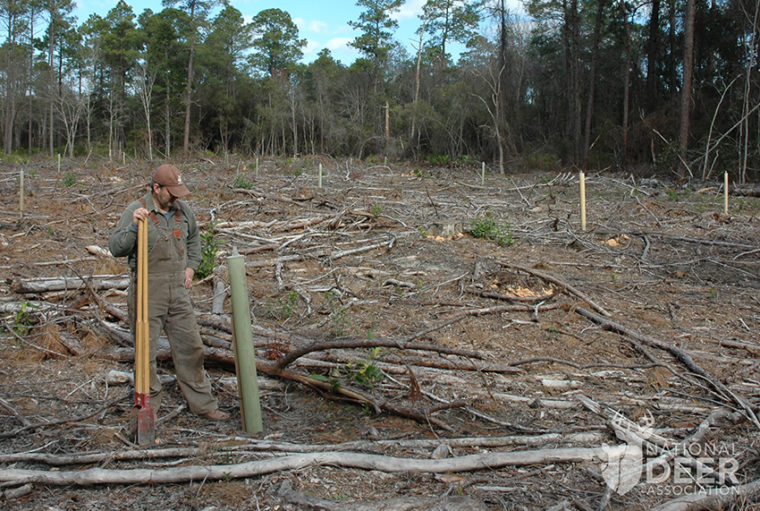I’ve been planting trees for deer habitat management since I started helping my dad when I was about 10 years old. I’m in my 40s now and still planting them. I’ve learned a lot about tree planting and made plenty of mistakes in that time. Whenever the subject comes up, friends who hunt always have a lot of questions about which trees to plant and how, so I decided to compile a list of my most useful tips, based on experience, for planting trees for deer hunting.
Go Native
Plant native tree species. Avoid non-native invasives like autumn olive. Some of these species do have wildlife benefits, but there are always native alternatives that are just as good or better. Choose those.
Go Local
Buy tree seedlings from a nursery that is in or near your climate zone and physiographic region. Trees that are adapted to your climate and soils are more likely to survive and thrive than varieties from far-flung regions.
Plant Trees You Don’t Have
Evaluate your existing hunting area and determine which tree species are already common (don’t plant more of those) and which tree species are under-represented or absent. Fill in the gaps.
Diversify
There is no single tree species that is the magic tree for deer. Diversity will always win this fight. Plant a diversity of trees of different kinds (hard mast and soft mast, plus various species in each group).
Red and White
Oaks fall into two major families: white oaks and red oaks. Both groups have advantages, so look for both groups when evaluating your tree needs.
Seedling Choice
You have a choice between bareroot seedlings (pulled out of the soil) and containerized (the roots are in soil in a tubelike container or pot). Bareroot are cheaper, but containerized enjoy slightly higher survival rates because there is no root damage in the transfer process. I have always ordered bareroot seedlings, and survival has been satisfactory because we follow all of the rest of the tips shown here.
Plant Dormant Seedlings
Order and plant trees in winter or early spring when seedlings are dormant. You get much higher survival on transplanted seedlings when you move them while they’re dormant.
Plant Seedlings ASAP
Once your seedlings arrive, get them in the ground as soon as possible. If you have to wait a few days to plant, keep the roots moist and store the seedlings in a cool, dark location in the meantime. Root damage is the critical factor in transplant survival. If the roots dry out, your seedling is dead.
Use Tree Tubes
Use tree shelters on every seedling. These plastic tubes are worth the extra expense because they protect the young seedlings from browsing and rubbing by deer. They also encourage vertical growth over horizontal branching until the seedling grows beyond the reach of deer and ground-level plant competitors. Here are more tips for using tree shelter tubes.
Plant in Full Sunlight
The more sun and space your seedlings have, the faster they will produce large, healthy crowns and the sooner they will produce mast. Science even shows that room to grow is the most important factor in acorn production, not soil fertility (watch the video below for more on this study).
Dig Shallow
Dig holes only deep enough to accommodate the roots or root ball of the seedlings. Digging deeper and back-filling may result in settling, and the seedling’s roots need to remain close to ground level. Backfill only with the native soil you took from the hole.
Skip the Fertilizer
Don’t fertilize seedlings. Tree seedlings require little or no fertilization, and it is actually easy to kill seedlings if you put down too much fertilizer. Sunlight, space, the right amount of moisture, and limited competition will do the most for tree growth and mast production. Put the fertilizer on your food plots.
Protect the Roots
Do not plant trees in the middle of food plots unless you leave a no-disk buffer around the seedling that extends at least as far as the horizontal reach of the branches. Disking underneath a tree cuts feeder roots that are near the surface, stressing and injuring the tree. Most eventually die from repeated root damage by disk harrows.
Create Huntable Orchards
Plant trees in huntable-sized orchards, with about 30 feet of space between hard mast trees and 20 for fruit trees. The photo above shows a 1-acre clearcut I planted in February 2013 with swamp chestnut oaks, a member of the white oak family that produces huge acorns loved by deer. This will make a great stand site one day for me, my kids, and their kids.
Sleep, Creep, Leap
Your seedlings will likely appear to sleep the first growing season, creep the second, and start leaping by the third. They’ll do even better if you return each year and control surrounding plants that are competing for sunlight, soil moisture and nutrients.
Good luck with your deer orchards, and good hunting!
This article was originally published in a longer form in NDA’s Quality Whitetails magazine. Join NDA today to start receiving Quality Whitetails and learning even more about deer hunting and habitat management!
